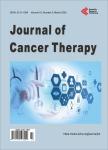Yolk Sac Tumor of the Ovary in 18 Egyptian Cases: Does It Really Differ?
Yolk Sac Tumor of the Ovary in 18 Egyptian Cases: Does It Really Differ?作者机构:Department of Surgical Oncology National Cancer Institute Cairo Egypt Department of Medical Oncology National Cancer Institute Cairo Egypt
出 版 物:《Journal of Cancer Therapy》 (癌症治疗(英文))
年 卷 期:2016年第7卷第4期
页 面:247-253页
学科分类:1002[医学-临床医学] 100214[医学-肿瘤学] 10[医学]
主 题:Yolk Sac Tumor Ovary Outcomes
摘 要:Background: Ovarian Yolk sac tumor (OYST) is a rare entity of malignant ovarian germ cell tumors (MOGCT). Abdominal pain, a rapidly growing distending mass or irregular vaginal bleeding is the main presentation. Serum AFP is elevated in nearly all cases. The standard management is fertility preserving surgery with adjuvant chemotherapy. Aim of Work: To report and analyze retrospectively recorded cases that were either treated at National Cancer Institute/Egypt or referred there for advice about therapy. Materials and Methods: This is a retrospective single-institutional analysis of 18 cases of OYST treated at National Cancer Institute-Cairo University from January 2011 till December 2015. The clinical and pathological characteristics, treatment, and outcomes of these patients were analyzed. Results: Data from eighteen patients were obtained. The median age was 18 years (range: 15 - 22). Abdominal pain was the most common presentation (89%). The mean tumor size was 21cm (range: 8 - 30 cm). Eleven of our cases (61%) were stage I, seven cases and (39%) were stage IV at presentation. Fifteen cases (83%) underwent fertility preserving procedure & the standard surgical staging. Panhysterectomy & formal staging procedure was done only in two cases (11%). One case (6%) underwent bilateral salpingo-oophorectomy. 2 cases (11.1%) only underwent lymph node biopsy. 11 patient (61.1%) showed pure type YST while mixed type was present in the remaining 7 cases (38.8%): Dysgerminoma (one case, 5.6%), Dysgerminoma + immature teratoma (one case, 5.6%), Immature teratoma (2 cases, 11.1%) and Teratoma (3 cases, 16.7%). AFP was extremely elevated in all cases at presentation (median 4191 ng/mL;ranging: 725 ng/mL - 402,908 ng/mL). It showed decreased level after surgery (median 145 ng/ mL;ranging: 2 ng/mL - 38,000 ng/mL) & normalized after chemotherapy except for progressive disease. All cases started BEP regimen after surgery with complete remission in twelve cases. In follow up period (



